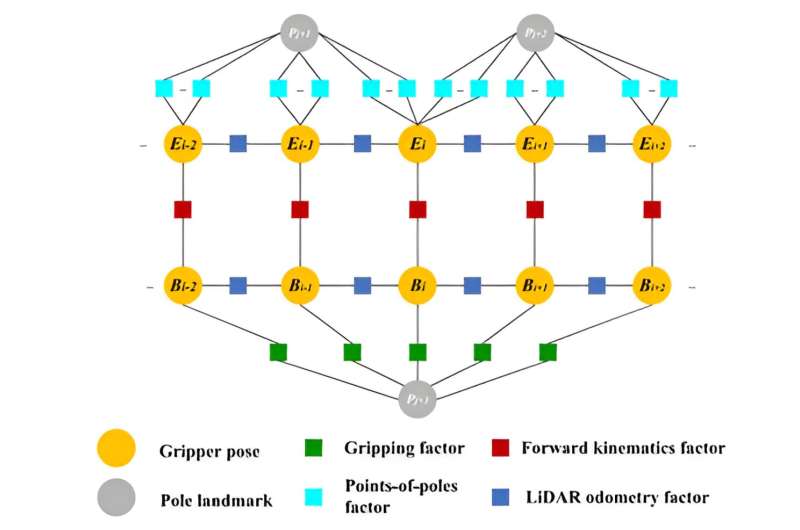A fusion SLAM system that enhances the sensing and localization capabilities of biped climbing robots

Climbing robots may have many beneficial real-world functions, starting from the completion of upkeep duties on roofs or different tall constructions to the supply of parcels or survival kits in places which are tough to entry. To be efficiently deployed in real-world settings, nonetheless, these robots ought to be capable of successfully sense and map their environment, whereas additionally precisely predicting the place they’re situated inside mapped environments.
Researchers at Guangdong University of Know-how lately developed a brand new technique to reinforce the flexibility of a bipedal climbing robotic to estimate its state and map its environment whereas climbing a truss (i.e., a triangular system consisting of straight interconnected parts, which might be a bridge, roof or one other man-built construction). Their proposed method, launched in Robotics and Autonomous Methods, is predicated on a simultaneous localization and mapping (SLAM) algorithm.
“Our recent work deploys SLAM methods to a particular biped climbing robot (BiCR), which was developed by our lab, named the Biomimetic and Intelligent Robotics Lab,” Weinan Chen, co-author of the paper, instructed Tech Xplore.
“BiCR is an electromechanical system similar to a moving manipulator that is able to move via grippers at both ends and rotate with multiple joints. The robot can be used for installation, maintenance, and inspection in high-altitude and high-risk environments, such as construction site scaffolding and power towers.”
The first goal of the latest research by Chen and his colleagues was to permit a bipedal climbing robotic to autonomously localize itself and create a map of environment whereas navigating environments characterised by truss constructions. The SLAM-based strategy they suggest was particularly utilized to BiCR, a bipedal climbing robotic beforehand developed at their lab.
“Since there are many differences in the configurations and working environments of the BiCR and other robots (ground vehicles, UAVs, etc.), this paper proposes a method that fuses robot joint information and environmental information to improve the localization accuracy of the BiCR,” Chen mentioned.

BiCR-SLAM, the simultaneous localization and mapping system developed by the researchers, makes use of details about the BiCR robotic’s configuration, a LiDAR sensing system and visible information collected by cameras to localize a robotic and map the truss it’s climbing. The framework can decide the pose of the robotic gripper and create a map of poles surrounding the gripper, in order that it may possibly higher plan its actions whereas climbing a truss.
“The framework consists of four components: an encoder dead reckoning, a LiDAR odometry estimation tool, a pole landmark mapping model, and a global optimization technique,” Jianhong Xu, one other writer of the paper, mentioned. “In the global optimization, we propose a multi-source fusion factor graph to jointly optimize the robot localization and pole landmarks.”
A notable benefit of BiCR-SLAM is that it concurrently considers info associated to the bipedal robotic’s joints and information collected by sensors. It thus permits the BiCR robotic to map its environment and predict its pose, utilizing this info to plan its subsequent strikes and safely climb a truss.
“The system can also keep working in some low-texture and single-structure truss environments,” Chen mentioned. “To the best of our knowledge, BiCR-SLAM is the first SLAM system solution to incorporate BiCR’s information for a truss map. This work can advance the development of BiCR and SLAM and improve BiCR’s localization and navigation performance in autonomous operations.”
Whereas Chen and his collaborators particularly designed their SLAM technique for the BiCR robotic, sooner or later it is also tailored and utilized to different climbing robots. Thus far, the crew used a single LiDAR system to sense poles inside a small sensing vary round a robot, however they quickly hope to additional advance its capabilities utilizing extra of those techniques together with deep studying strategies.
“In our next studies, we plan to use multiple LiDARs to sense pole objects using deep learning approaches that are free from the calibration of the external parameters between various sensors,” Chen added.
“We also plan to use the sensing configuration with a more extensive scanning range to improve segmentation accuracy and apply this work to the autonomous navigation of climbing robots. Specifically, we will integrate the motion planning part to realize an autonomous navigation function.”
Extra info:
BiCR-SLAM: A multi-source fusion SLAM system for biped climbing robots in truss environments. Robotics and Autonomous Methods(2024). DOI: 10.1016/j.robot.2024.104685.
© 2024 Science X Community
Quotation:
A fusion SLAM system that enhances the sensing and localization capabilities of biped climbing robots (2024, April 8)
retrieved 8 April 2024
from https://techxplore.com/information/2024-04-fusion-slam-localization-capabilities-biped.html
This doc is topic to copyright. Aside from any truthful dealing for the aim of personal research or analysis, no
half could also be reproduced with out the written permission. The content material is offered for info functions solely.
Click Here To Join Our Telegram Channel
Source link
In case you have any issues or complaints concerning this text, please tell us and the article will probably be eliminated quickly.






